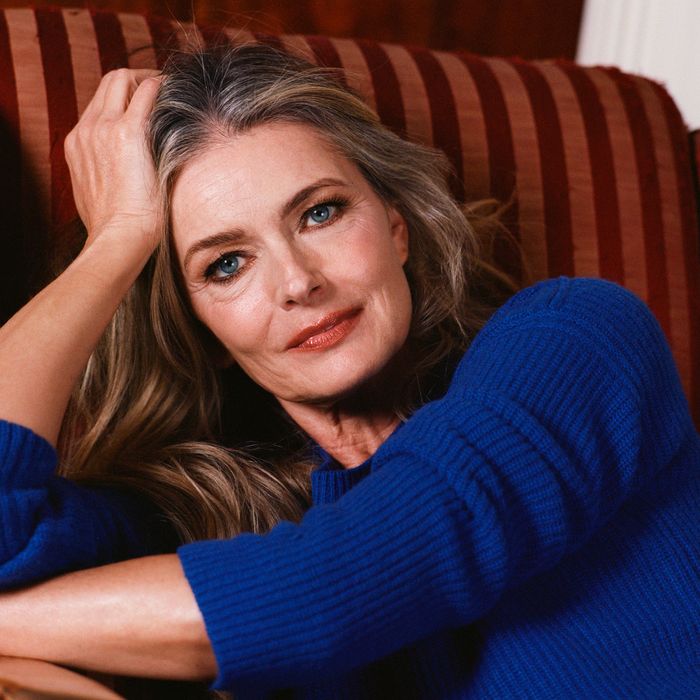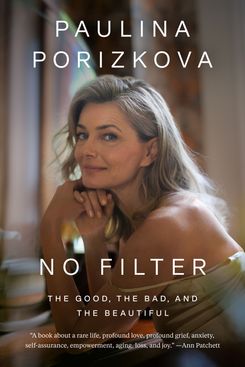
She was so close I could smell her coffee-and-cigarette breath. It was reassuring. Proof she was human. In this new, unfamiliar, ambiguous world, everyone seemed towering and godlike to me.
The only sources of light in the cavernous studio were the round naked lightbulbs around the mirror. The trestle table under the mirror was laid out with makeup on one side and hair tongs, a blow-dryer, and hair products on the other.
The woman opened half a dozen small glass bottles filled with beige liquids, poured them out on the back of her hand, and blended them with a brush, gauging the color by smudging little bits of the mixture on my chin. When she was satisfied, she stepped close to me, leaned over, and, with the brush, began to apply the color on my face.
I was fifteen, and it was only my fourth booking. I was still filled with fear that this would be the day I would be found out; the day I was told that I didn’t belong here, that someone made a mistake, that I was no model. I smiled frenetically to assure the makeup artist that I was a nice and accommodating girl. She didn’t seem to notice.
I closed my eyes to the flutter of the wet brush against my skin. I heard a door open and peeked from beneath my eyelids. The blackness behind me was momentarily flooded with blue light. A shadow stepped in; then the door closed and the back of the room disappeared into darkness again.
“Bonjour!” the photographer shouted across the room. I had met him only briefly in a go‑and-see, but I recognized him immediately and my stomach knotted even harder. By then, I understood that the makeup and hair people and the photography assistants were merely the lesser gods, while the photographer was Zeus, wielding absolute power over his domain. If he didn’t like you, you went home. That happened on my second job, shortly after I had been dressed in my first outfit. That photographer, after hurling a bunch of instructions at me in French — which I failed to obey since I didn’t understand them — snorted, put his camera down, and, with a wave of his all-powerful hand, dismissed me from the set. I went back to my little room in an apartment that was owned by the director of my agency and cried the rest of the day while I waited to be handed an airplane ticket back to Sweden. Instead I got another job, where the photographer seemed to like me just fine.
Every day, it was a different photographer, different crew, different room. Every day, I had to make new friends and figure out what was wanted from me. Every day, I had to decipher a new language. Every day, I was the new kid in school.
I watched in the mirror as the photographer sidled up behind me and placed something warm and yielding on my shoulder. I kept smiling. The thing on my shoulder looked like a large brown flower in the reflection, and I got a whiff of something food-like, soup-like. A soft, heavy pretzel? Pantyhose stuffed with mashed potatoes? The room was silent except for the pop of an umbrella flash followed by a high-pitched whine as the photo assistant tested the equipment nearby. The makeup artist moved aside a little and laughed. Her laughter assured me this was funny. I joined in, giggling, although I had no idea what I was laughing at.
I kept staring at myself and this odd thing in the mirror. My shoulder was at the same height as the photographer’s crotch. Finally, I turned my head to look at it directly and realized it was attached to his body. Attached to the part of his body where a penis would be. It rested there, casually, nestled between my collarbone and the side of my neck. I looked back at us in the mirror.
He grinned at me as if this was a fun little joke. The makeup artist shook her head lightly and raised her eyebrows, as if to say, “Here he goes again!”
I had seen photos and illustrations of penises in health and biology classes at school, but I had never seen a real penis before, and certainly not one held up right next to my face. Could it be?
I wanted to jump up and get away from it. But with another woman laughing, I thought my impulse must be wrong. Her laughter made the whole thing seem … lighthearted. Inconsequential. Like I’d ruin the fun if I didn’t laugh along. I kept smiling. I needed them to like me.
It wasn’t until he retracted that thing on my shoulder, stuffed it back in his pants, and zipped up that I knew for certain that, yes, it really, actually had been his penis.
When you are a child, you take your cues about your environment from the adults around you. Your mom lets you know this new supermarket is a safe space by the way she calmly navigates it with her cart. Your teacher is at home in her classroom and soon you will be too. A child will find their eventual normal in whatever setting they encounter.
This first encounter with a penis was to be my new normal. I quickly assumed it was a part of the job, and I wasn’t wrong.
I long ago lost count of how many times I was greeted by a photographer in a gaping bathrobe. If it wasn’t the photographer, it was a client, or the nephew of a client, or one of the client’s friends. It happened so often it became just another day on a shoot. In fact, if a photographer well-known for being creepy didn’t try something, I’d feel uneasy, insecure. It meant that I wasn’t as attractive as the other girls who were getting harassed. Harassment, perversely, became a confirmation of desirability.
Being a model was about inspiring desire in the photographer — who was, nearly all of the time, male. If the photographer was a straight man, it was about inspiring sexual desire. If he was gay, it was about embodying an abstract idea of beauty. You had to become a work of art, a sculpture, a painting. In either case, you had to become a man’s idealized version of a woman: beautiful, sexual, perfect.
The sexual tension at a shoot wasn’t a side effect. It was something you wanted, because it would make for better photos. I knew how to create sexual tension well before I’d actually had sex. Even so, there was a photographer who once shouted at teenaged, virgin me, “Look at me like you want me to cum!”
I asked, “Come where?”
He never booked me again.
Now, as a fifty-seven-year-old woman, it’s not lost on me that the sexualized ideal woman you saw on the covers of magazines forty years ago did not know a penis when it was literally pulled out right in front of her face. Because the ideal woman was not a woman at all. She was a girl.
In modeling, careers start young and often end young. When you are taught the rules as a child, you don’t question them. I was told models had to be young, because their smooth skin reflected light in a way that older faces did not. But I suspect there is another, darker reason for having seventeen-year-olds hawking antiwrinkle creams.
All models were and still are called girls. Regardless of age. Why are there no women in modeling?
Because a girl doesn’t know to say no. A girl does not know her own power. A girl does not know her value. Because she wants people to like her, she puts up with things she never
should have.
And yet, what is held up as the ideal of physical womanhood today — the perky full breasts, tiny waist, perfectly rounded behind, large eyes, tiny nose, full lips, thick hair, and smooth skin — are the attributes of a teenager.
We have created a giant industry of antiaging products and a booming plastic surgery business that subsist on our insecurities. I myself was a part of this, selling the dream of youth to a world hungry for it. I sold antiaging creams to women closer to my mother’s age when my skin was effortlessly taut. I sold calendars with my mostly unclothed body to men who were old enough to be my father, when I was just growing into that exposed body. I didn’t know any better. What teenager does? I was a part of a well-oiled machine set in motion long ago. As a child, I didn’t question the rules.
Now, as a woman in her fifties with a life well lived and many lessons learned, I’ve come to find out I’m still supposed to look like the girl who doesn’t know what a penis is.
The danger isn’t just in setting up that impossible beauty standard. It’s in what that standard represents and demands of women. Which is that we not only look like girls, but act like them too. If the ideal woman is seventeen, then the ideal woman is naive, malleable, inexperienced, and undiscerning. The ideal woman is not a woman. She’s a girl.
From NO FILTER by Paulina Porizkova, to be published on November 15, 2022 by The Open Field, an imprint of Penguin Publishing Group, a division of Penguin Random House, LLC. Copyright © 2022 by Paulina Porizkova.





